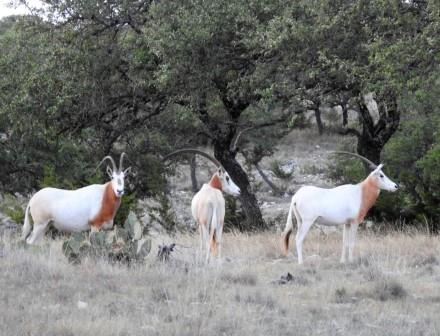
The Scimitar-horned Oryx, also known as the Sahara Oryx, is an antelope that originated from the Sahara and Sahel regions of North Africa; but as of the 1980’s had been extinct in the wild. In 2016 conservationists released 23 animals in the grasslands of Chad with the goal to release several hundred over the next few years. Most founder bloodlines for scimitars currently located in North America and Europe derive from two captures that took place in Chad in 1963 and 1966.
These animals are mostly white bodied with reddish brown necks, tufted tail, and markings on their face. They can be as tall as 4-5 feet at the shoulder, be 4-8 feet in length, and weigh between 200-460 pounds. The males and female both have horns that curve backwards (the only Oryx with curved horns) that can grow beyond 36 inches with the males having a tendency to have more mass and the females generally having more length.
The Scimitar-horned Oryx is an opportunistic breeder with births peaking in March and October. Gestation is 8-8.5 months with the female giving birth to one calf. They congregate in herds with a dominate male leading. The Scimitar Oryx feed on grasses, succulents, foliage, and have a very low requirement of water.
The Scimitar-horned Oryx was known to be domesticated by ancient Egyptians and used as food and sacrifices to the gods. The Scimitar horned Oryx is believed to be the original unicorn when someone viewed one with a broken horn and so the story began!
The Scimitar-horned Oryx has been introduced to the Texas Hill Country and is thriving, with a larger population on Texas ranches then there existed in the wild. Hunting this animal is an opportunity not only for a beautiful trophy but some of the best eating meat!
 The Scimitar-horned Oryx, also known as the Sahara Oryx, is an antelope that originated from the Sahara and Sahel regions of North Africa; but as of the 1980’s had been extinct in the wild. In 2016 conservationists released 23 animals in the grasslands of Chad with the goal to release several hundred over the next few years. Most founder bloodlines for scimitars currently located in North America and Europe derive from two captures that took place in Chad in 1963 and 1966.
The Scimitar-horned Oryx, also known as the Sahara Oryx, is an antelope that originated from the Sahara and Sahel regions of North Africa; but as of the 1980’s had been extinct in the wild. In 2016 conservationists released 23 animals in the grasslands of Chad with the goal to release several hundred over the next few years. Most founder bloodlines for scimitars currently located in North America and Europe derive from two captures that took place in Chad in 1963 and 1966.